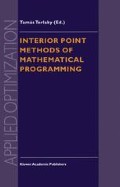Abstract
Interior point methods, originally invented in the context of linear programming, have found a much broader range of applications, including global optimization problems that arise in engineering, computer science, operations research, and other disciplines. This chapter overviews the conceptual basis and applications of interior point methods for some classes of global optimization problems
Access this chapter
Tax calculation will be finalised at checkout
Purchases are for personal use only
Preview
Unable to display preview. Download preview PDF.
References
I. Adler, M.G.C. Resende, G. Veiga, and N. Karmarkar. An implementation of Karmarkar’ s algorithm for linear programming.Mathematical Programming, 44: 297–335, 1989.
F. Alizadeh. Optimization over positive semi-definite cone: Interior-point methods and combinatorial applications. In P.M. Pardalos, editor,Advances in Optimization and Parallel Computing, pages 1–25. North-Holland, Amsterdam, 1992.
I.I. Dikin. Iterative solution of problems of linear and quadratic programming.Soviet Math. Doklady, 8: 674–675, 1967.
K. Fujisawa and M. Kojima. SPDA (Semidefinite Programming Algorithm)–User’ s manual. Technical Report B-308, Tokyo Institute of Technology, Department of Mathematical and Computing Sciences, Tokyo, December 1995. Program available at ftp: //ftp. is. titech. ac. jp/pub/OpRes/software/SDPA.
G.H. Golub and C.F. Van Loan.Matrix Computations. The Johns Hopkins University Press, Baltimore, 1989.
C.-G. Han, P.M. Pardalos, and Y. Ye. On the solution of indefinite quadratic problems using an interior point algorithm.Informatica, 3: 474–496, 1992.
R. Horst and P.M. Pardalos, editors.Handbook of Global Optimization. Kluwer Academic Publishers, Amsterdam, 1995.
R. Horst, P.M. Pardalos, and N.V. Thoai.Introduction to Global Optimization. Kluwer Academic Publishers, Amsterdam, 1995.
A.P. Kamath and N. Karmarkar. A continuous method for computing bounds in integer quadratic optimization problems.Journal of Global Optimization, 2: 229–241, 1992.
A.P. Kamath and N. Karmarkar. AnO(nL) iteration algorithm for computing bounds in quadratic optimization problems. In P.M. Pardalos, editor,Complexity in Numerical Optimization, pages 254–268. World Scientific, Singapore, 1993.
A.P. Kamath, N. Karmarkar, K.G. Ramakrishnan, and M.G.C. Resende. A continuous approach to inductive inference.Mathematical Programming, 57: 215–238, 1992.
A.P. Kamath, N. Karmarkar, K.G. Ramakrishnan, and M.G.C. Resende. An interior point approach to Boolean vector function synthesis. InProceedings of the 36th MSCAS, pages 185–189, 1993.
A.P. Kamath, N. Karmarkar, N. Ramakrishnan, and M.G.C. Resende. Computational experience with an interior point algorithm on the Satisfiability problem.Annals of Operations Research, 25: 43–58, 1990.
N. Karmarkar. An interior-point approach for NP-complete problems.Contemporary Mathematics, 114: 297–308, 1990.
N. Karmarkar, M.G.C. Resende, and K. Ramakrishnan. An interior point algorithm to solve computationally difficult set covering problems.Mathematical Programming, 52: 597–618, 1991.
N. Karmarkar, M.G.C. Resende, and K.G. Ramakrishnan. An interior point approach to the maximum independent set problem in dense random graphs. InProceedings of the XIII Latin American Conference on Informatics, volume 1, pages 241–260, Santiago, Chile, July 1989.
N.K. Karmarkar. A new polynomial time algorithm for linear programming.Combinatorica, 4: 373–395, 1984.
M. Kojima, N. Megiddo, T. Noma, and A. Yoshise.A unified approach to interior point methods for linear complementarity problems. Lecture Notes in Computer Science. Springer-Verlag, 1991.
K. Levenberg. A method for the solution of certain problems in least squares.Quart. Appl. Math., 2: 164–168, 1944.
O.L. Mangasarian. Characterization of linear complementarity problems as linear programs.Mathematical Programming Study, 7: 74–87, 1978.
D. Marquardt. An algorithm for least-squares estimation of nonlinear parameters.SIAM J. Appl. Math., 11: 431–441, 1963.
R.D.C. Monteiro, I. Adler, and M.G.C. Resende. A polynomial-time primal- dual affine scaling algorithm for linear and convex quadratic programming and its power series extension.Mathematics of Operations Research, 15: 191–214, 1990.
R.D.C. Monteiro and Y. Wang. Trust region affine scaling algorithms for linearly constrained convex and concave programs. Technical report, Georgia Institute of Technology, Atlanta, GA, June 1995. To appear inMathematical Programming.
J.J. Moré and D.C. Sorenson. Computing a trust region step.SIAM J. of Stat. Sci. Comput., 4: 553–572, 1983.
P. M. Pardalos, Y. Ye, C.-G. Han, and J. Kaliski. Solution of P-matrix linear complementarity problems using a potential reduction algorithm.SIAM J. Matrix Anal. & Appl, 14: 1048–1060, 1993.
P.M. Pardalos. Continuous approaches to discrete optimization problems. In G. Di Pillo and F. Giannessi, editors,Nonlinear optimization and applications. Plenum Publishing, 1996.
P.M. Pardalos and J.B. Rosen. Global optimization approach to the linear complementarity problem.SIAM J. Scient. Stat. Computing, 9: 341–353, 1988.
M.V. Ramana.An algorithmic analysis of multiplicative and semidefinite programming problems. PhD thesis, The Johns Hopkins University, Baltimore, 1993.
M.G.C. Resende and P.M. Pardalos. Interior point algorithms for network flow problems. In J.E. Beasley, editor,Advances in linear and integer programming. Oxford University Press, 1996.
C.-J. Shi, A. Vannelli, and J. Vlach. An improvement on Karmarkar’ s algorithm for integer programming. In P.M. Pardalos and M.G.C. Resende, editors, COAL Bulletin —Special issue on Computational Aspects of Combinatorial Optimization, number 21, pages 23–28. 1992.
T. Tsuchiya and M. Muramatsu. Global convergence of a long-step affine scaling algorithm for degenerate linear programming problems. Technical Report 423, The Institute of Statistical Mathematics, Tokyo, 1992. To appear inSIAM J. Opt.
Stephen A. Vavasis.Nonlinear Optimization, Complexity Issues. Oxford University Press, Oxford, 1991.
J.P. Warners, T. Terlaky, C. Roos, and B. Jansen. Potential reduction algorithms for structured combinatorial optimization problems. Technical Report 95–88, Delft University of Technology, Delft, 1995.
J.P. Warners, T. Terlaky, C. Roos, and B. Jansen. A potential reduction approach to the frequency assignment problem. Technical Report 95-98, Delft University of Technology, Delft, 1995.
Y. Ye. A new complexity result on minimization of a quadratic function with a sphere constraint. In C.A. Floudas and P.M. Pardalos, editors,Recent Advances in Global Optimization, pages 19–21. Princeton University Press, Princeton, 1992.
Y. Ye. On affine scaling algorithms for nonconvex quadratic programming.Mathematical Programming, 56: 285–300, 1992.
Y. Ye and P.M. Pardalos. A class of linear complementarity problems solvable in polynomial time.Linear Algebra and its Applications, 152: 3–17, 1991.
Author information
Authors and Affiliations
Editor information
Editors and Affiliations
Rights and permissions
Copyright information
© 1996 Kluwer Academic Publishers
About this chapter
Cite this chapter
Pardalos, P.M., Resende, M.G.C. (1996). Interior Point Methods for Global Optimization. In: Terlaky, T. (eds) Interior Point Methods of Mathematical Programming. Applied Optimization, vol 5. Springer, Boston, MA. https://doi.org/10.1007/978-1-4613-3449-1_12
Download citation
DOI: https://doi.org/10.1007/978-1-4613-3449-1_12
Publisher Name: Springer, Boston, MA
Print ISBN: 978-1-4613-3451-4
Online ISBN: 978-1-4613-3449-1
eBook Packages: Springer Book Archive

